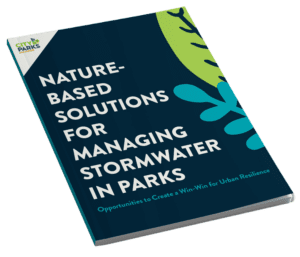As storms become more intense and unpredictable, our infrastructure must adapt. Parks, forest reserves, greenways, and trails are among the largest green spaces in cities and, being under public ownership, have great potential for green infrastructure.
By managing stormwater naturally, green stormwater infrastructure (GSI) helps reduce flooding and its financial impacts while protecting ecosystems and enhancing biodiversity. Green infrastructure in parks can improve public health by reducing water pollution and urban heat while increasing green spaces, all of which can lower healthcare costs related to respiratory and heat-related illnesses. It also can enhance a city’s climate resilience and create green jobs.
However, due to several barriers, our parks and public green spaces are underutilized for GSI.

A Policy Brief for Policymakers, Organizational Leaders, and Advocates
in the Parks and Stormwater Sectors
Starting in September 2023, City Parks Alliance worked with a cohort of parks and stormwater agency leaders from eight cities across the country to inform how to increase collaboration between the parks and stormwater management sectors and address historic inequities. The project is in partnership with the US Water Alliance and the Green Infrastructure Leadership Exchange with funding support from the Robert Wood Johnson Foundation.
Guided by existing research and the experience of these practitioners in our cohort, we’ve created a policy to highlight the co-benefits of GSI projects in urban parklands to help inspire more GSI projects in parks in more cities. The brief:
- Identifies and addresses the systemic barriers to better collaboration between parks and stormwater management agencies and their partners,
- Shares recommendations and calls to action for public leaders and policy advocates to help overcome them, and
- Shares examples and resources to help cities tap into the public benefits and opportunities that GSI in parks can provide.
